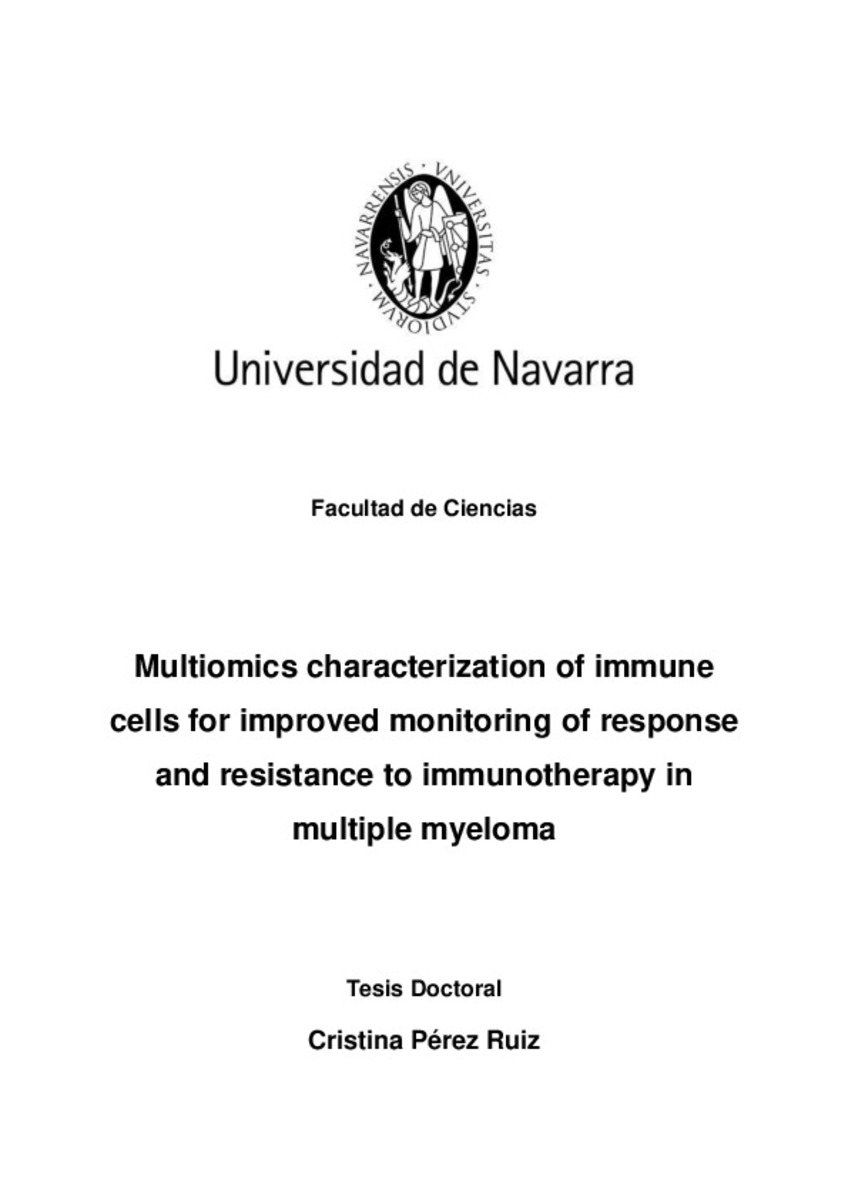Full metadata record
| DC Field | Value | Language |
|---|---|---|
| dc.contributor.advisor | Lourenço-Paiva, B.D. (Bruno David) | - |
| dc.contributor.advisor | Merino, J. (Juana) | - |
| dc.creator | Perez, C. (Cristina) | - |
| dc.date.accessioned | 2022-09-30T09:40:20Z | - |
| dc.date.available | 2022-09-30T09:40:20Z | - |
| dc.date.issued | 2022-09-30 | - |
| dc.date.submitted | 2022-09-13 | - |
| dc.identifier.citation | PÉREZ, Cristina. "Multiomics characterization of immune cells for improved monitoring of response and resistance to immunotherapy in multiple myeloma". Lourenço, B.D. y Merino, J. (dirs.). Tesis doctoral. Universidad de Navarra, Pamplona, 2022 | es_ES |
| dc.identifier.uri | https://hdl.handle.net/10171/64360 | - |
| dc.description.abstract | The role of immunotherapy in the treatment of multiple mieloma (MM) has grown notoriously in recent years. Not all patients respond to these drugs and the duration of response is variable. The unpredictable clinical benefit together with their excessive cost, urges the identification of new biomarkers for next-generation immune profiling that could facilitate the individualization of immunotherapy. The simultaneous availability of advanced flow cytometry and (single-cell) sequencing will deliver unprecedented resolution in the characterization of immune cells. Knowledge on the molecular traits of immune response will contribute to the phenotypic identification of key immune cell types that determine response vs resistance to immunotherapy. Once identified, it would be possible to investigate the prognostic value of well-defined immune subsets according to previously unknown phenotypes and propose new markers for next-generation immune profiling in MM. G-MDSCs promote tumor growth and immunosuppression in MM. However, their phenotype is not well established for accurate monitoring. The preestablished phenotype of G-MDSCs was evaluated in bone marrow (BM) samples from controls and MM patients using multidimensional flow cytometry; CD11b+CD14-CD15+CD33+HLADR- cells overlapped with eosinophils and neutrophils, which were not expanded in MM patients. Automated clustering unbiasedly identified all granulocytic subsets in the tumor microenvironment: basophils, eosinophils, and immature, intermediate and mature neutrophils. In 267 newly diagnosed MM patients, only the frequency of mature neutrophils at diagnosis was significantly associated with patient outcome, and a high mature neutrophil/T-cell ratio resulted in inferior progression-free survival. Upon FACSorting of each neutrophil subset, T-cell proliferation decreased in the presence of mature neutrophils, and the cytotoxic potential of T cells engaged by a BCMA×CD3-bispecific antibody increased notably with the depletion of mature neutrophils. RNA sequencing of the 3 subsets revealed that G-MDSC-related genes were specifically upregulated in mature neutrophils from MM patients vs controls because of differential chromatin accessibility. These results establish a correlation between the clinical significance, immunosuppressive potential and transcriptional network of well-defined neutrophil subsets, providing for the first time a set of optimal markers (CD11b/CD13/CD16) for accurate monitoring of G-MDSCs in MM. Tumor recognition by T cells is essential for anticancer immunity and a deeper knowledge of T cells is needed for immune profiling. Thus, we used single-cell RNA and T-cell receptor sequencing to characterize 75,753 T cells from healthy adults (HA) and patients with MGUS, SMM and active MM, to define the phenotype of clonal T cells throughout myelomagenesis. A reduced diversity of clonal T cells in benign and malignant BM, together with partial displacement of non-clonotypic by clonotypic T cells in MM, were observed. Clonal T cells were characterized by a progressively exhausted phenotype that started in MGUS/SMM and peaked in MM. The transcriptional phenotype of clonotypic T cells was subsequently used to leverage multidimensional and computational flow cytometry data available in 1,148 BM aspirates from HA, MGUS, SMM, newly-diagnosed and relapsed/refractory MM patients. Increased percentages of T cells with phenotypic traits of clonality identified SMM patients with a median time-to progression to active disease of 24 months. The ratio between CD27 negative and positive T cells was significantly associated with T-cell clonality throughout myelomagenesis, and survival in transplant-ineligible and -eligible patients treated with lenalidomide. This study sheds light into the timing of T cell exhaustion during disease progression and identified a new immune biomarker to predict survival in MM patients treated with lenalidomide combination therapy. | es_ES |
| dc.language.iso | eng | es_ES |
| dc.publisher | Universidad de Navarra | es_ES |
| dc.rights | info:eu-repo/semantics/openAccess | * |
| dc.subject | Materias Investigacion::Ciencias de la Salud::Oncología | es_ES |
| dc.subject | Multiple myeloma | es_ES |
| dc.subject | Immunotherapy | es_ES |
| dc.title | Multiomics characterization of immune cells for improved monitoring of response and resistance to immunotherapy in multiple myeloma | es_ES |
| dc.type | info:eu-repo/semantics/doctoralThesis | es_ES |
| dc.identifier.doi | 10.15581/10171/64360 | - |
Files in This Item:
Statistics and impact
Items in Dadun are protected by copyright, with all rights reserved, unless otherwise indicated.






